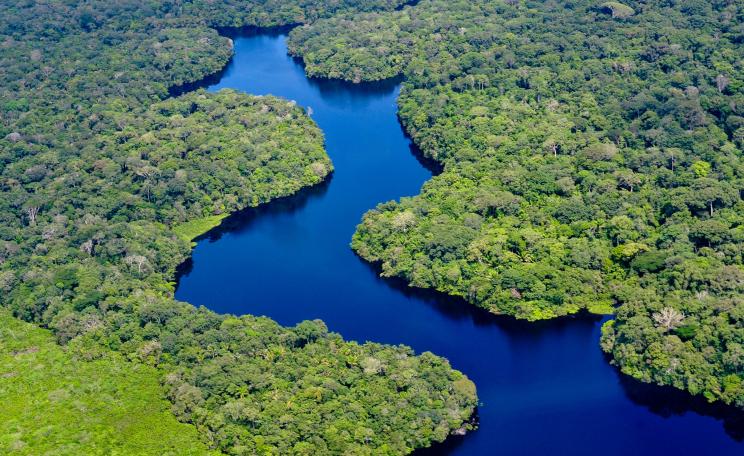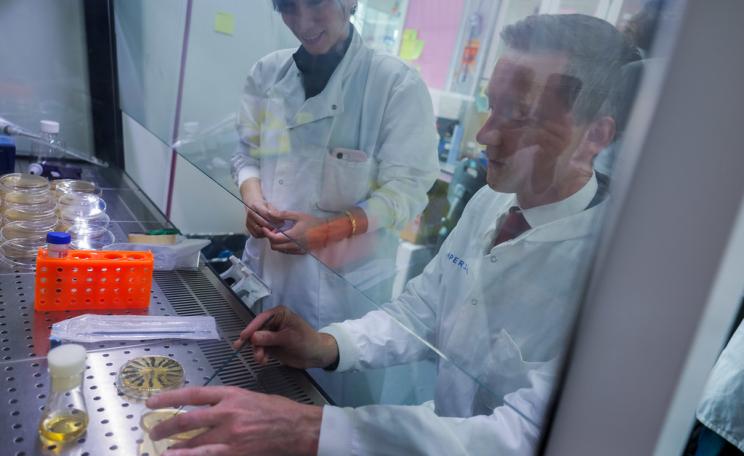.
Preserving the Amazon rainforest isn’t just an environmental concern: it’s a matter of survival. It’s the most biodiverse place on the planet, a reservoir of life-saving medicines, and a critical regulator of our planet’s climate. Our health, our survival, and the balance of our world rely on its protection.
Yet the Amazon's diverse ecosystem is under threat from rampant deforestation, degradation, and climate change, jeopardising its ability to act as a carbon sink. This degradation increases the likelihood of zoonotic diseases emerging and spreading, posing a significant public health risk for Brazil and the world.
Climate change, deforestation, alterations in land use, agricultural expansion, livestock farming, mining activities, biodiversity loss, urbanisation, oil and gas extraction, and large-scale infrastructure developments, such as road and dam construction in the Amazon rainforest, have all been associated with the rise and spread of infectious diseases.
Zoonotic
These include dengue, yellow fever, malaria, Zika virus, Chikungunya fever, Candida auris, leishmaniasis, Oropouche virus, hantavirus, and numerous others, with the possibility of also introducing novel pathogens.
In 2023, Brazil recorded 1,079 deaths from dengue fever, a 20.9 per cent increase compared to the previous year. The country reported over 217,000 cases between January 1 and January 30, marking a significant 233 per cent increase from the same period in 2023, when there were just over 65,000 cases, according to the ministry of health. In 2024, Brazil recorded approximately 408,351 potential cases of dengue, as per data from the Ministry of Health's Arbovirus Monitoring Panel.
According to a report published by the World Health Organisation (WHO) in 2023, the country experienced around 2.9 million suspected cases of dengue. This significant rise in dengue cases may be attributed to factors such as the El Niño phenomenon, deforestation, and the impact of climate change, which can lead to more frequent and severe weather events.
The Aedes aegypti mosquito is the vector for transmitting diseases such as the dengue virus, yellow fever, Zika, and chikungunya viruses. Brazil’s Health Surveillance Foundation (FVS) has recently reported that a new strain of the Oropouche virus has been responsible for outbreaks in the Brazilian Amazon region over the past two years. In the state of Amazonas alone, there were 1,066 recorded cases of the virus between 2023 and 2024.
Oropouche fever is caused by an arbovirus transmitted through the bite of a mosquito called Culicoides paraense, commonly known as maruim. The Amazon rainforest is recognised as one of the largest reservoirs for zoonotic diseases, which can be transmitted from animals to humans.
Emerging
Numerous scientists have consistently warned about the environmental imbalances linked to the escalating prevalence of infectious diseases and have drawn attention to the imminent risk of a deadly pathogen emerging from the Amazon rainforest.
The interaction between humans and wild species, along with their pathogens, creates opportunities for the emergence of zoonotic diseases, facilitating the transmission of new pathogens across various host species, a phenomenon known as "spillover", leading to the introduction of novel infections into the human population.
For spillover events to happen, there must be interaction among different species and favourable conditions for pathogens to spread among humans. One example is the transmission of bat-borne diseases, such as rabies, in the Amazon rainforest. This is often associated with factors like deforestation, agricultural expansion, and the presence of livestock, which increase contact between these animals and humans and facilitate the transmission of infections.
Various types of animals, including monkeys, bats, and mosquitoes, can serve as carriers or vectors of infectious diseases to humans, as they carry pathogens like viruses, bacteria, fungi, parasites, and prions. Transmission of these pathogens to humans can occur through direct contact with these animals or via water, food, or the surrounding environment. Sars, Ebola, Hendra, and Nipah are examples of pathogens from bats that have triggered outbreaks in the human population.
Joel Henrique Ellwanger, biologist and researcher at the department of genetics at Federal University of Rio Grande do Sul (UFRGS), said: “Climate change will trigger important ecological changes in the Amazon, many of them with the potential to reduce its biodiversity, facilitating the spread of known disease vectors and increasing the chances of new diseases emerging.”
Pathogens
The impact of climate change and deforestation is causing a surge in extreme weather events and rising temperatures. These conditions are impacting the quantity of vectors, transmission patterns and interspecies interactions, driving the spread of infectious diseases across the Amazon region and throughout Brazil.
Severe droughts in the Amazon rainforest can create conditions to the spread of various diseases, such as dengue. During periods of limited rainfall, residents often resort to storing water in tanks, consequently creating breeding grounds for mosquitoes.
“For instance, as temperatures rise, mosquitoes become more active and reproduce at a higher rate. Furthermore, changes in climate may cause animals carrying pathogens to migrate to areas where humans reside,” said Ellwanger.
The increase in cases of Candida auris, a fungus resistant to multiple drugs associated with hospital-acquired infections, may be caused by higher temperatures resulting from climate change. This pathogen affects severely ill patients, including both adults and children, who are receiving intensive care in hospitals across the globe.
Ellwanger explained how climate change may have played a role in the surge of Candida auris: “Climate change can influence the evolution of pathogens. Certain microorganisms, once unable to infect humans because they were accustomed to lower temperatures, are now adapting to warmer conditions that mimic the human body's warmth.
Epidemics
"This adaptation creates the potential for these microorganisms, typically present in soil and similar settings, to infect humans and cause illnesses. This phenomenon is believed to have happened with Candida auris.”
Studies suggest that deforestation, biodiversity loss and habitat degradation create pathways for disease agents to transition from the diverse reservoir of various coronaviruses and pathogens in the region into the human population. The Amazon's vulnerable healthcare system additionally complicates the detection and containment of any emerging pandemic from this area.
When exploring the emergence of epidemics, urbanisation becomes another critical factor to consider. It contributes to the depletion of forested areas, consequently increasing the risk of infectious diseases in regions like the Amazon rainforest. The outbreak of Zika virus infection in Brazil has been associated with urbanization and the loss of forested lands.
The construction of roads in the Amazon rainforest contributes to deforestation, forest fires, biodiversity decline, increased hunting activities, and human migration, directly impacting the dynamics of infectious diseases.
Between 1970 and 1973, the building of the Trans-Amazonian highway, known as BR-230, led to the influx of around 22,000 individuals to the area. These individuals encountered disease vectors, exposing them to various illnesses such as malaria, leptospirosis, leishmaniasis, Chagas disease, Mayaro fever, yellow fever, and numerous others.
Livestock
A study published in the Journal of Racial and Ethnic Health Disparities warns that the reconstruction of the Amazon’s BR-319 highway could result in devastating environmental effects, including an increased risk of zoonotic spillovers, potentially leading to new pandemics.
The Amazon’s BR-319 highway, extends 886km and connects the central Amazonian capital Manaus to the southern boundary of the forest in Porto Velho, crossing through one of the most preserved sections of the forest. Deforestation along the central portion of the BR-319 has already resulted in a 400 per cent increase in malaria cases.
A recent study published in Nature alerts that the initiatives of president Luiz Inácio Lula da Silva's administration to construct roads and pursue oil exploration in the Amazon area may potentially trigger a new worldwide pandemic.
The construction of hydroelectric dams in the Amazon rainforest also raises significant concern. One example is the Belo Monte hydroelectric dam complex in Brazil, located in the northern region of the Xingu River within the state of Pará. This project has significantly changed the landscape of the Brazilian Amazon, inundating an area of approximately 516 km2.
Flooding dry regions within the rainforest leads to loss of biodiversity and creates habitats suitable for disease vectors like mosquitoes, thereby intensifying the proliferation of viral and parasitic illnesses. Dams can lead to the displacement of communities and the migration of populations drawn to forested regions, potentially increasing human-wildlife interactions, and the transmission of infectious diseases.
Agriculture
The implementation of proposed projects in the Amazon rainforest, including the reconstruction of BR-319 highway and the exploration of oil, could result in catastrophic and irreversible consequences, including an increase and spread of infectious diseases, due to environmental degradation in the region.
“Meat connects different points involving the degradation of the Amazon and emerging diseases. Cattle farming is one of the main factors in the degradation of the Amazon biome, thus facilitating the spread of pathogens in the region.
"Hunting and the consumption of wild animal meat is a problem both for the conservation of species and for public health, as it reduces animal biodiversity and increases the chances of spillover events. Regrettably, this issue remains largely overlooked and is often deemed taboo in Brazil,” explained Ellwanger.
Studies suggest that intensified agriculture and forest conversion for farming and pasture for cattle, increase human-pathogen interaction, promoting the emergence of viral, bacterial, and parasitic infections.
Workers in the meat industry regularly interact with livestock animals and may lack adequate working conditions to reduce the risk of zoonotic pathogen transmission. Additionally, they may have limited knowledge about the health risks associated with their work activities.
Slaughterhouses within the Amazon region are implicated in the processing of animals sourced from deforested areas and may be operating without any form of health inspection.
Another concern is the excessive use of antimicrobial drugs in veterinary practice. The main drivers of antimicrobial resistance (AMR) include the overuse of antibiotics in livestock for growth promotion and prevent diseases, particularly in intensified livestock farming.
The World Health Organisation (WHO) describes AMR as the overlooked pandemic. Some of the latest figures suggest that AMR will cause 10 million deaths by the year 2050, more than from cancer, diabetes and pneumococcal diseases combined.
Bushmeat
According to Cóilín Nunan, scientific adviser to the Alliance to Save Our Antibiotics, certain types of antibiotics used in animal farming have led to the rise and spread of livestock associated strains of MRSA and Clostidrium difficile.
Oxford University scientists published a study revealing Escherichia coli bacteria that have developed resistance to colistin in animal agriculture. Nunan highlights this as a significant concern, suggesting it might pose a greater threat than antimicrobial resistance (AMR) by potentially increasing the likelihood of infections in humans.
The hunting and consumption of bushmeat from wild animals can also lead to spillover events, as humans come into close contact with fresh meat, blood, and organs from infected animals. Approximately 473 tons of wild animal meat are sold annually in the Amazon rainforest, across Colombia, Peru, and Brazil. It's essential to recognise that a complete ban on bushmeat consumption in certain regions could impact the livelihoods of thousands who depend on this activity.
Measures
Ellwanger discussed the essential measures required to prevent the emergence and spread of infectious diseases in the Amazon rainforest and avert the onset of a new pandemic in the region,
They explained: “Certain crucial measures must be undertaken, including improving livestock sanitary measures, increasing pathogen surveillance, upgrading environmental sanitation systems, discouraging human settlement in forested regions, boosting investments in human training and specialised labs for pathogen identification, creating new vaccines, and examining biological and social factors affecting infection susceptibility.
“The loss of biodiversity in the Amazon is mainly caused by livestock farming, mining activities and monoculture cultivation, especially soy. Combating these activities is the responsibility of the Brazilian Government by strengthening environmental protection bodies, preserving, and expanding indigenous territories, and committing to a serious environmental agenda,” added Ellwanger.
Furthermore, urgent action is needed to prioritise reducing greenhouse gas emissions globally, alongside combating deforestation and protecting indigenous territories. It's crucial to reassess infrastructure projects and manage human activities in the region carefully. Suspending oil and gas exploration in the Amazon is essential, as is regulating the expansion of intensive agriculture, cattle farming, and mining projects.
Ellwanger explained that preserving the Amazon rainforest should be in everyone’s interest. “The preservation of the Amazon isn't just about protecting nature - it's about safeguarding our own health. Let's commit to conserving this vital ecosystem to ensure that the threats of potential pathogens stay confined to the wild, far from endangering human lives. After all, the health of the Amazon means the health of us all.”
This Author
Monica Piccinini is a freelance writer, focused on environmental, health and human rights issues.







